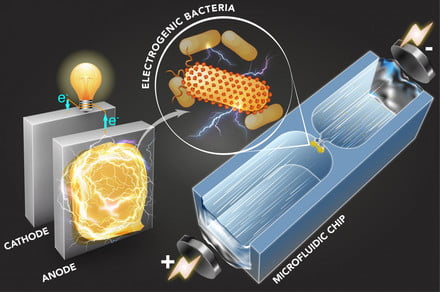A new development in bacteriology could allow microbes to be used to run fuel cells and purify sewage water, according to a team at Massachusetts Institute of Technology (MIT)’s Department of Mechanical Engineering.
Bacteria have been identified which have evolved a unique form of breathing in oxygen-poor environments by producing electricity. These bacteria can be found in environments where oxygen supply is limited, like deep inside mines, at the bottom of lakes, and even inside our own bodies in the human gut. They generate electrons within their cells, then transfer the electrons through their cell membranes in a a process known as extracellular electron transfer (EET). This means that they excrete electrons and they could be used to form a microbial fuel cell which generates electricity by capturing these electrons.
The MIT team has made progress in achieving this goal by developing a new microfluidic technique which can process samples of bacteria to see if they are able to produce electricity. They measure a property known as polarizability, or the ability to form instantaneous dipoles, which is known to be highly correlated with bacteria’s electricity production ability.
This technique is safer and more efficient than existing techniques which require growing large batches of cells and looking for the activity of proteins which are active in the EET process. The traditional approach requires either meticulous and time-consuming identification of the proteins, or alternatively the destructive rupturing of cells to probe the proteins inside.
The microfluidic chips developed by the MIT team are etched with tiny channels which samples of bacteria can flow through, with an hourglass-shaped pinch in each channel. When a voltage is applied to the channel, the small size of the pinched section squeezes the electric field to make it much stronger than in the surrounding area. This creates a phenomenon known as dielectrophoresis where particles can be stopped or repelled depending on their surface properties — in this case, according to the bacteria’s electrochemical activity.
A microfluidic technique quickly sorts bacteria based on their capability to generate electricity. Qianru Wang
“There is recent work suggesting there might be a much broader range of bacteria that have [electricity-producing] properties,” Cullen Buie, associate professor of mechanical engineering at MIT, said in a statement. “Thus, a tool that allows you to probe those organisms could be much more important than we thought. It’s not just a small handful of microbes that can do this.”
Editors’ Recommendations
- Exciton transistors could create the energy-efficient electronics of the future
- New research could allow fast diagnosis of viruses like Ebola and Zika
- Researchers develop ‘green liver’ houseplant that cleans the air in your home
- Awesome Tech You Can’t Buy Yet: Germ-killing faucets, the ultimate charging tray
- What is graphene?

